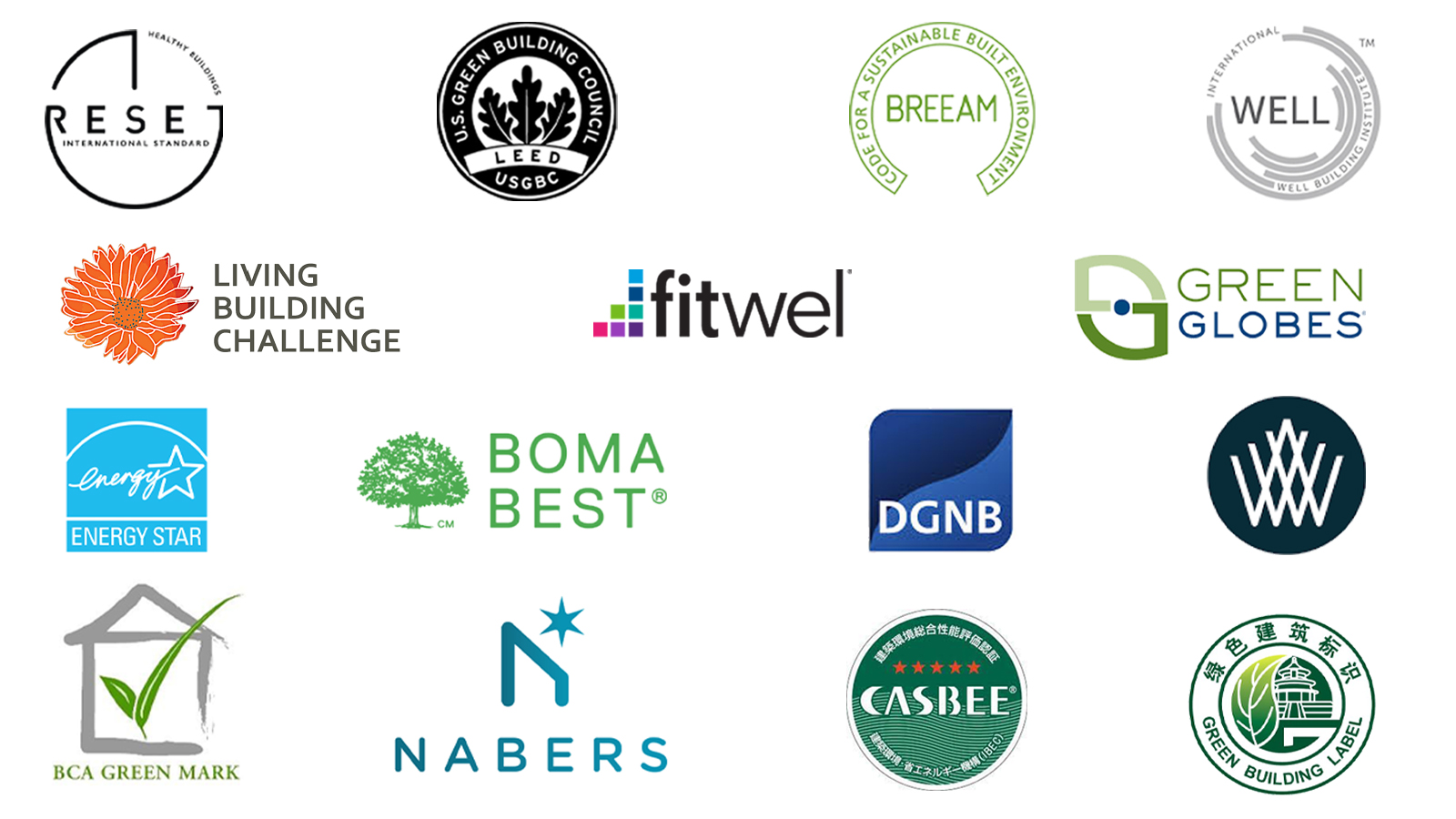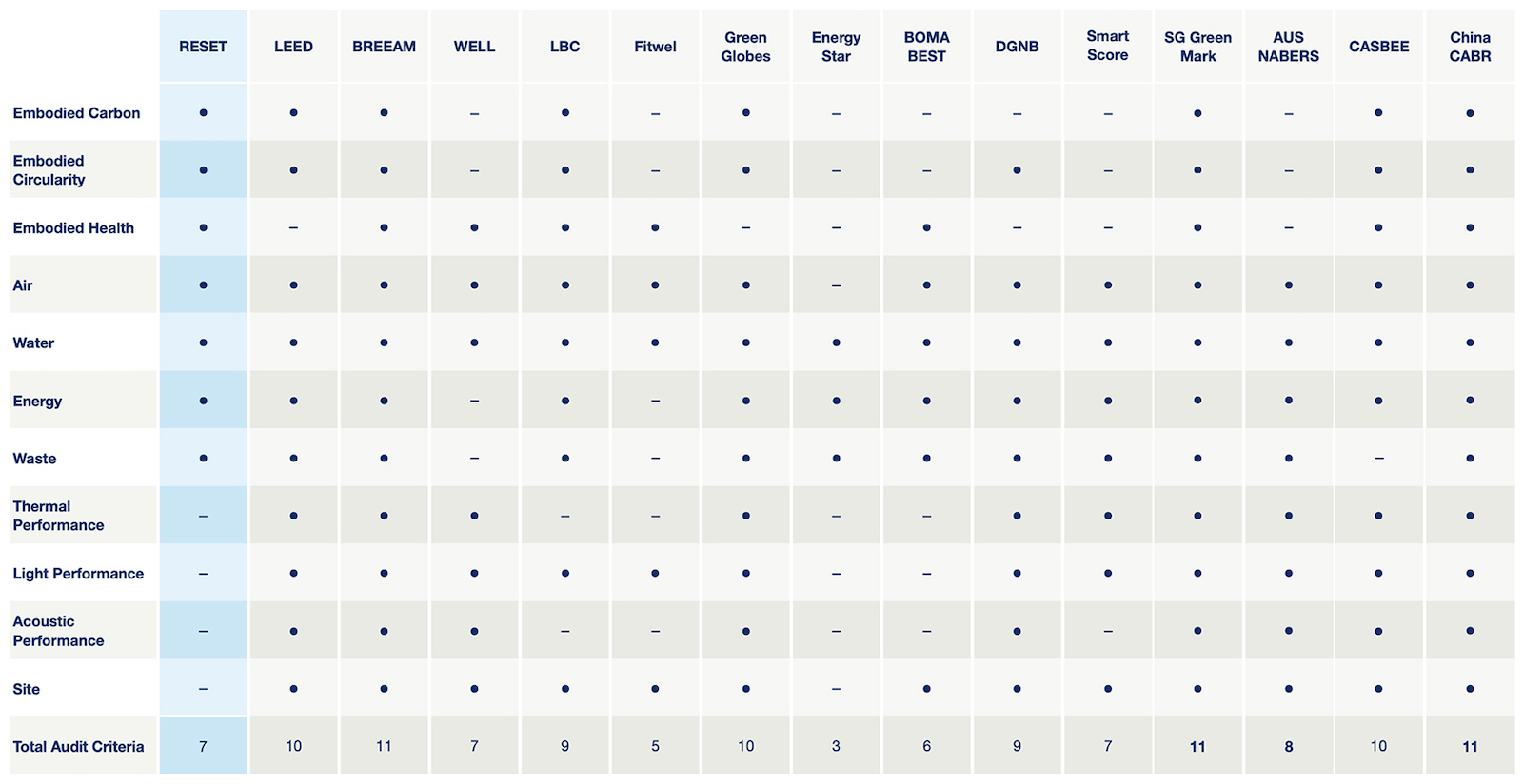Comparing Building Standards from Around the World

A few weeks ago, we were asked about how RESET compares against other building standards. We took this opportunity to create our first content request of 2023: a comparison of building standards from around the world.
This report compares 15 of some of the most widely recognized and used green building standards in current markets. Each standard is compared and summarized across multiple aspects, including criteria, data requirements, scoring system, etc. We hope this report can provide a basic guideline when choosing building standards and also give a clearer understanding of the similarities and differences between each standard.
The following table shows a summary of all the building standards and how we will be comparing them:
(you might need to download the images or zoom in to see the details)
● Applicable ○ Optional - Not Applicable
Introduction
Let's start with a brief introduction of each building standard:
RESET: the world’s leading performance-driven building certification program, founded in Canada in 2013, globally certified projects;
LEED: the most popular green building standard, founded in the US in 1998, globally certified projects;
BREEAM: the earliest green building standard, founded in the UK in 1990, globally certified projects;
WELL: the world’s leading standard for healthy buildings, founded in the US in 2014, collaborated with LEED and AUS NABERS, globally certified projects;
LBC: the most difficult to achieve green building standard, founded in the US in 2006, globally certified projects;
Fitwel: the world’s leading standard for healthy buildings, founded in the US in 2016, globally certified projects;
Green Globes: a Canadian green building standard, founded in Canada in 2000, mainly leveraged in North America;
Energy Star: one of the most famous energy standards, founded in the US in 1995, globally certified projects and products;
BOMA BEST: the world’s leading standard for sustainable buildings and building management, founded in 2005 in Canada, globally certified projects;
DGNB: the world’s leading green building standard, founded in 2007 in Germany, globally certified projects;
SmartScore: a new-style standard for smart buildings by WiredScore, founded in the US in 2013, mainly leveraged in the US, EU, and APAC;
SG Green Marks: a Singaporean green building standard, founded in Singapore in 2005, mainly leveraged in Asia Pacific;
AUS NABERS: an Australian green building standard, founded in Australia in 1998, mainly leveraged in Australia, New Zealand, and the UK;
CASBEE: a Japanese green building standard, founded in Japan in 2001, mainly leveraged in Japan;
China CABR: the first Chinese green building standard, founded in China in 2006, mainly leveraged in China.
Sustainability & Health
Green building standards mainly focus on two aspects: sustainability and health. Some standards might focus on one or the other, while others will do both. A standard will have a sustainability focus if it takes into account sustainable performance, while it will have a health focus if it takes into account the health performance of buildings.
The following table lists whether or not a standard focuses on sustainability and/or health:
Criteria
Criteria refers to the criteria for which building performance is reviewed by each standard. Due to the different emphasis of each building standard, each standard will consist of different criteria. The following table compares a summary of the criteria audited by every standard:
Embodied Carbon: Embodied Carbon consists of the GHG emissions associated with building construction, including those that arise from extracting, transporting, manufacturing, and installing building materials on site, as well as the operational and end-of-life emissions associated with those materials;
Embodied Circularity: Embodied Circularity refers to the recycling performance of materials used, including source-of-life and end-of-life;
Embodied Health: Embodied Health refers to the impact of the material components on human health, including VOC emissions and material ingredients;
Air: Air refers to indoor air quality, including indicators such as CO₂, PM2.5, TVOC, etc;
Water: Water refers to anything water related, including water consumption and water quality;
Energy: Energy refers to anything energy related, including energy consumption and production locally;
Waste: Waste refers to anything waste related, including the amount of waste generated;
Thermal Performance: Thermal Performance refers to the thermal insulation performance, often including its influence on occupants;
Light Performance: Light Performance refers to the lighting condition, often including its influence on occupants;
Acoustic Performance: Acoustic Performance refers to the sound insulation performance, often including its influence on occupants;
Site: Site refers to the project's ecological situation, traffic situation, etc.
Modularization
Modularization refers to whether customers can freely pick and choose certification criteria from the standard according to their project situation, funding situation, preferences, etc.
The following table compares whether each standard has modularization options:
Only RESET and LBC have modularization options. For RESET, there are 7 separate standards for their 7 criteria and clients can freely choose which standard they want to implement and audit according to their own needs. For LBC, modularization is based on petals with strict conditions. Currently, optional petals only include the water petal, the energy petal, and the material petal.
The rest of the standards do not have modularization options. Clients need to select standards based on building attributes and project type accordingly, for which certification criteria and requirements will be different.
Cloud Service
Cloud Service refers to whether or not there is an online platform provided by the standard for project registration, document submission, performance data viewing, etc.
The table below summarizes and compares whether the standards offer a cloud service:
All mainstream international standards have online cloud services except for CASBEE and China CABR.
Data Service
Data Service refers to whether standards need to audit the performance data of projects to achieve certification.
The description of the different data services is explained below:
Consumption Data: Refers to whether standards need to summarize performance data for audit. Is it necessary, optional, or a plus;
Continuous Monitoring: Refers to whether standards require continuous monitoring data for audit. Is it necessary, optional, or a plus;
Live Data Audit: Refers to whether standards audit the live performance data of projects and whether monitors can stream real-time results;
Data Transparency: Refers to whether clients can view or receive real-time performance data from computers or mobile devices to get a better understanding of their buildings.
Scoring System
Scoring System means whether projects need to earn points to achieve every certification.
The table below shows whether a standard utilizes a scoring system:
Below is a brief introduction to the rating levels if applicable:
RESET: the only standard that projects do not need to earn points to achieve. RESET audits the performance data directly;
LEED: certified level, silver level, gold level, and platinum level;
BREEAM: pass level, good level, very good level, excellent level, and outstanding level;
WELL: silver level, gold level, and platinum level;
LBC: pass level, and fail level;
Fitwel: one-star level, two-star level, and three-star level;
Green Globes: one green globes level, two green globes level, three green globes level, and four green globes level;
Energy Star: Energy Star will show the final score of the project directly;
BOMA BEST: certified level, bronze level, silver level, gold level, and platinum level;
DGNB: bronze level, silver level, gold level, and platinum level;
SmartScore: certified level, silver level, gold level, and platinum level;
SG Green Marks: certified level, gold level, gold plus level, and platinum level;
AUS NABERS: one-star level, two-star level, three-star level, four-star level, five-star level, and six-star level;
CASBEE: C level, B- level, B+ level, A level, S level;
China CABR: one-star level, two-star level, and three-star level.
Project Types
The following table summarizes project types that can be certified by every standard:
Detailed classifications for every standard is listed below:
RESET: New and Existing Buildings; Interior and Core & Shell;
LEED: New buildings, New interiors, Existing buildings and spaces, Neighborhood development, Cities and communities, Residential, Retail;
BREEAM: New construction, Refurbishment & fit out, In-use, Communities, Infrastructure;
WELL: Owner occupied, WELL Core (Core & Shell);
LBC: New and Existing Buildings; Interior and Core & Shell;
Fitwel: New construction, Existing building;
Green Globes: New construction, Core & Shell, Sustainable interiors, existing buildings;
Energy Star: Commercial building;
BOMA BEST: Existing buildings;
DGNB: New construction, Existing buildings, Interiors;
SmartScore: Office buildings, Residential buildings;
SG Green Marks: Non-residential buildings, Residential buildings, Existing non-residential buildings, Existing residential buildings;
AUS NABERS: Commercial buildings, Residential buildings;
CASBEE: New construction, Existing buildings, Residential buildings, Communities;
China CABR: Commercial buildings, Residential buildings.
Pricing
Lastly, we have pricing. There wasn't a great way to directly compare pricing since a lot of the rules are different, so we opted to provide URL links instead. Pricing URL links of each standard can be found below:
BREEAM: https://files.bregroup.com/breeam/FS021_BREEAM-In-Use_Fee-Sheet.pdf
WELL: https://www.wellcertified.com/certification/v2/pricing
Green Globes: https://thegbi.org/green-globes-certification/what-it-costs/
Energy Star: https://www.energystar.gov/buildings/about_us/newsroom/media_faqs
BOMA BEST: https://bomacanada.ca/bomabest/fees/
DGNB: https://www.dgnb-system.de/en/certification/certification-fees/index.php
SmartScore: N/A
SG Green Marks: https://www1.bca.gov.sg/buildsg/sustainability/green-mark-certification-scheme/green-mark-assessment-fees
AUS NABERS: https://www.nabers.gov.au/ratings/pricing
CASBEE: N/A
China CABR: N/A
This report is a work in progress and we intend to add it to our Resources page in the following weeks.
In the mean time, if you have any comments or feedback (i.e. mistakes, content you want us to add, etc.), please do not hesitate to let us know by emailing us at info@reset.build.





